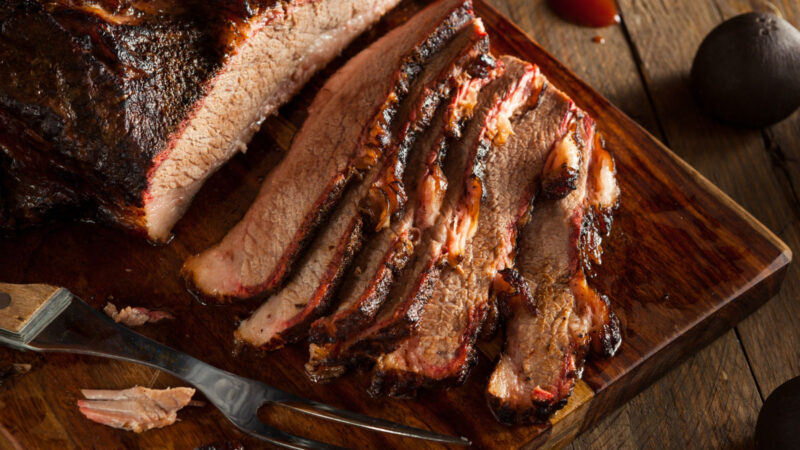As a seasoned culinary enthusiast, I’ve witnessed the remarkable transformation of brisket from its humble beginnings to a revered delicacy. What is brisket, you ask? This commendable cut hails from the anterior location of the bovine, the lower chest, and serves as one of the primal cuts of beef due to its impressive size.
Initially earmarked for ground beef production, brisket’s narrative has taken a turn as its popularity has soared, especially within the smoky realms of Texas barbecue and the hallowed traditions of Jewish holidays.
In the United States alone, brisket meaning has evolved beyond just a piece of meat — it symbolizes a craft, a challenge for pitmasters and home cooks alike to transform a tough cut into a tender masterpiece.
The brisket’s popularity has ascended so much that despite its once economical grace, it now commands a higher price, reflective of its stature as a centerpiece on menus from Korea to the backyard smokers of North America.
Key Takeaways
- The term brisket refers to a cut of beef from the cow’s lower chest, known for its significant size and connective tissue.
- Historically used for ground beef, brisket has grown in stature to become a highly sought-after cut for smoking and braising.
- Brisket’s cultural relevance is strong, especially in Texas barbecue and Jewish holiday feasts, where it plays a starring role.
- The brisket’s intrinsic toughness necessitates careful cooking methods to achieve an inviting tenderness and depth of flavor.
- Despite being a once economical choice, brisket’s surge in culinary popularity has impacted its market value, now seen as a specialty cut.
Unveiling the Brisket: A Cut Above the Rest
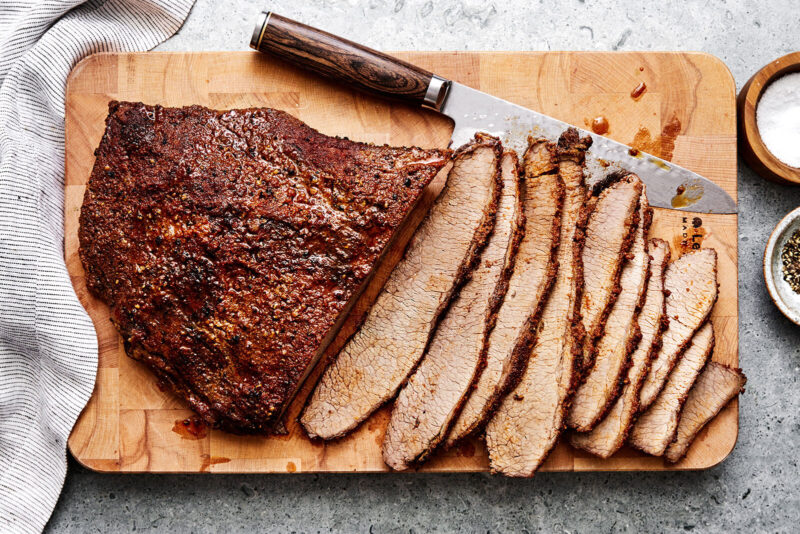
As brisket continues to claim its rightful throne in the pantheon of prized meats, it is my pleasure as a culinary aficionado to unveil the secrets behind its meteoric rise to fame.
The irresistibly rich, beefy flavor of a well-cooked brisket is nothing short of legendary; its journey to perfection requires adopting techniques steeped in cultural tradition and tailored to its unique attributes.
Whether it be the robust, smoky allure of a Texas-style brisket or the tender, savory succulence of a braised brisket in a Jewish holiday meal, the adaptability of this cut is unparalleled.
Seemingly tough and unyielding at first glance, brisket capitulates under the care of patient, low and slow cooking, emerging as a dish that commands attention on the dining table. Below, I share my insights on brisket types and provide invaluable cooking tips, allowing every home chef to achieve brisket bliss.
| Brisket Type | Description | Recommended Cooking Method |
|---|---|---|
| Flat Cut | A leaner section with a consistent thickness, ideal for even cooking. | Smoking ‘low and slow’ to maintain moisture |
| Point Cut | A fattier, richer piece with more marbling, yielding a more pronounced flavor. | Braising to tenderize the connective fibers |
The beauty of brisket lies in its transformation — an alchemy cultivated through hours of cooking, where every turn of flame and degree of smoke deepens its complexities and charms the palate.
- Selecting your Brisket: Look for good marbling and a bright, rich color. Don’t shy away from fat — it equals flavor.
- Preparing for the Cook: Trim the fat cap to an even thickness for consistent rendering. Season generously.
- Mastering the Cook: Maintain a consistent, low temperature, and be patient — this is the key to a fall-apart, tender brisket.
- Serving with Pride: Allow the cooked brisket to rest, slice against the grain, and watch as it rewards you with each melt-in-your-mouth bite.
Embracing these brisket recipes and cooking tips, even the fledgling home cook can produce results that resonate with the sophistication of a seasoned pitmaster. The brisket types each offer their own narrative of texture and taste, inviting a creative approach to seasoning and cooking that transcends regional confines.
Now, as I continue to explore the endless possibilities that brisket presents, I invite you to do the same, harnessing the knowledge shared today to craft your own trademark brisket dish. The journey is as rewarding as the destination, and in the world of brisket, every bite tells the story of dedication to the craft of cooking.
The Rise to Fame: Brisket’s Culinary Evolution
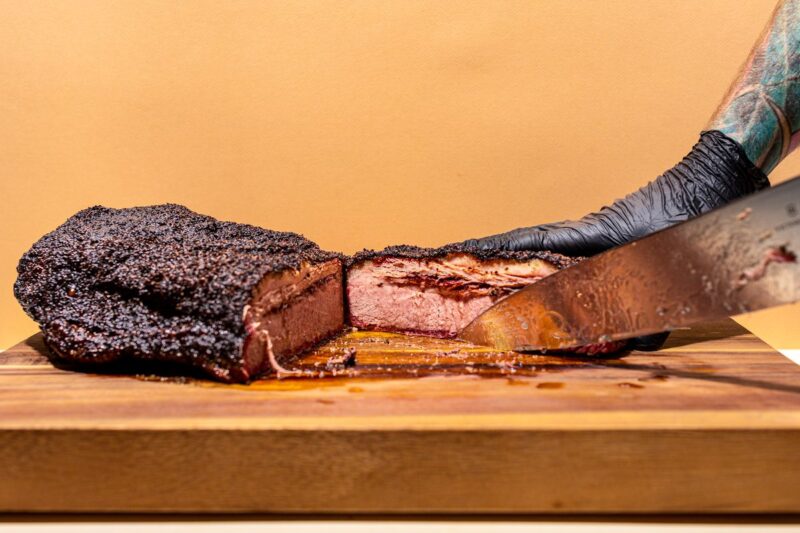
When I think about the brisket history, it tells a tale of humble beginnings—a cut so often ground into burger meat, reaching little acclaim. Yet, as witness to its gastronomic ascent, I’ve watched brisket transformation unfold within the pages of culinary lore.
A meat once economical, serving as mere sustenance, brisket has emerged, showcasing versatility and flavor that’s found favor in the most sophisticated of palettes. This evolution epitomizes how culinary trends can elevate a simple ingredient to a piece of art.
My investigation into the brisket’s rise reveals chapters where this 4-legged creature’s cut transcended its traditional role. It has been embraced and elevated by cultures worldwide, each imprinting upon it a regional signature that resonates with their heritage and taste.
From Ground Beef to Gourmet
The trajectory from its position in the background to the culinary limelight illustrates brisket’s remarkable transformation. The affordability that earmarked brisket for ground beef in the past has given way to creativity in the kitchen.
This shift mirrors the economic and gastronomic narratives that have redefined food norms over the years. Therein lies the underappreciated beauty of brisket: its ability to adopt the essence of the cook’s intent, transforming from a mere slice of beef into a cultural centerpiece on the plate.
Global Flavors: Brisket Around the World
On this global journey, brisket adapts, champions regional flavors, and becomes interwoven with traditions from Korea to Pakistan to England. The infusion of smoky, spicy, savory, and sometimes sweet accompaniments has granted brisket a place on the world stage, asserting its status as a true global brisket delicacy.
Its culinary versatility is a passport across borders—I’ve savored brisket in a multitude of forms. Slow-cooked, smoker-laden brisket in Texas; tenderly braised with traditional spices for Jewish holidays; and even simmered in soups or curries in Asian cuisines, brisket’s adaptability is boundless.
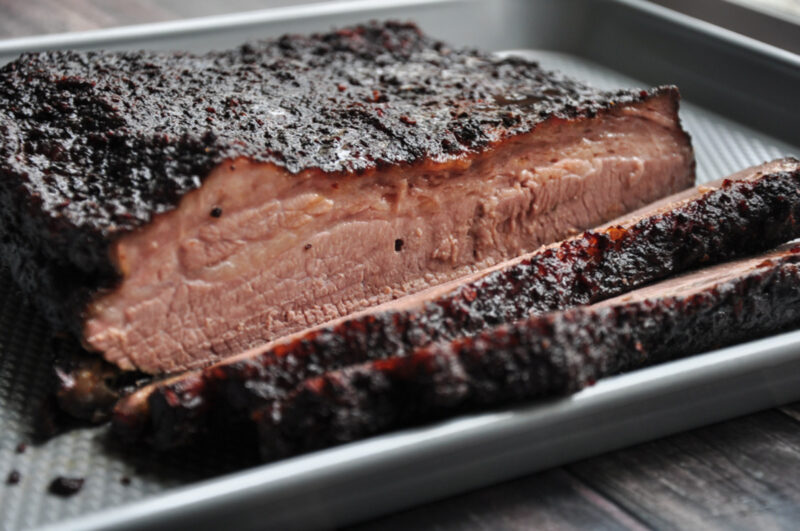
| Country | Culinary Preparation | Unique Flavor Profile |
|---|---|---|
| United States (Texas) | Smoked | Bold, peppery with a pronounced smoky essence |
| Jewish Cuisine | Braised | Rich, aromatic with subtle sweetness |
| Hong Kong | Incorporated in soups and curries | Complex, spiced, meltingly tender |
As I’ve marveled at brisket’s trajectory, from a meat of necessity to an ingredient celebrated for its robust flavors and adaptability, I recognize it as quintessential to understanding how food evolves.
My exploration of brisket continues, and I’m eager to witness its ongoing story of endurance, resilience, and reinvention. As lovers of food, let us embrace this journey, learning and taking with us the flavors that brisket—this one-time underdog—brings to our global table.
Defining the Brisket: Understanding the Cut
As I delve into the intricacies of brisket, I recognize that this cut is more than just a piece of meat; it’s a testament to the artistry behind proper butchering and cooking methods. Brisket, deriving from the muscular pectoral region of cattle, bears the weight of the animal, contributing to its characteristic toughness.
This cut’s resilience is born from the abundance of connective tissue that intertwines within the muscular fibers, posing a formidable challenge to both craft and knife.
The quest for brisket tenderness beckons a judicious approach in both preparation and cooking. The rich interconnected fibers, coupled with moderate fat content, set the stage for a culinary journey where patience and technique become paramount.
These elements, woven into the very fabric of brisket, encompass flavors that are profound—able to satisfy even the most discerning palate when coaxed with appropriate care.
At the heart of achieving unparalleled flavor and texture in brisket is a honed brisket cooking technique.
The transformation from a tough, unyielding cut to a tender delight is achieved through a low-heat, slow-cooking process—allowing the time necessary for the connective tissues to gently break down, merging with the fat to accentuate brisket’s depth and richness.
There’s a certain alchemy in brisket preparation: low heat melds with time to transmute the ordinary into the sublime, unveiling a tenderness that resonates with heartiness and warmth.
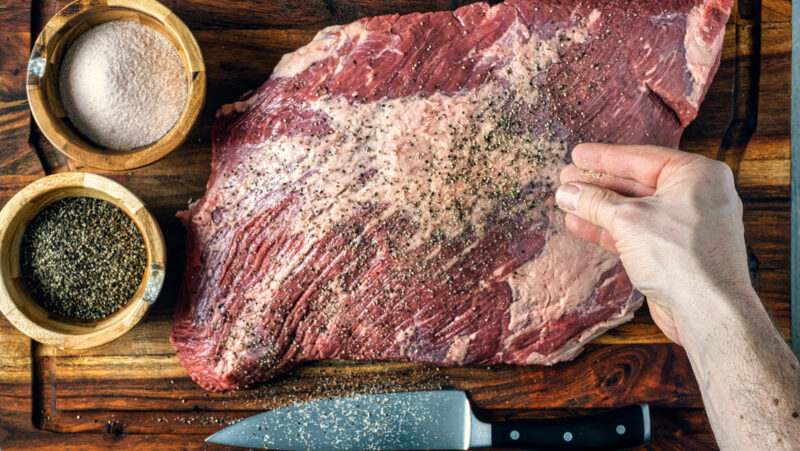
- Understanding the role of connective tissue in brisket’s toughness
- Appreciating the moderate fat content as an indicator of flavor potential
- Recognizing low and slow as the quintessential technique for achieving desired tenderness
Armed with this foundational knowledge of what constitutes brisket’s anatomy and essence, one can navigate the waters of brisket preparation confidently, transforming this once humble cut into a show-stopping culinary experience.
It is with these principles in mind that I regard every brisket as a blank canvas—awaiting the masterful strokes of flavor through the slow dedication of time and low-fired heat.
Brisket’s Transformation: Cooking Techniques for Perfection
My devotion to the culinary arts has led me to appreciate the nuances of brisket preparation. Achieving brisket perfection is more than a process—it’s a culinary rite of passage, indicative of skill and patience.
Esteemed for its flavor and texture when mastered, the key lies within two quintessential cooking methods that honor the meat’s tough, connective nature.
The Art of Low and Slow
The revered technique of low and slow cooking elevates the humble brisket to heights unknown. Within the confines of my smoker, the brisket undergoes a remarkable transformation, with temperatures meticulously controlled between 203°F to 205°F.
The goal is clear: a tender texture, a mouthwatering crust, and an infusion of smoke that whispers tales of the firewood’s essence.
Patience is the secret ingredient in the art of perfecting Smoked Brisket. Hours invested, wood selected, and temperature scrutinized, all pour their influence into the aromatic symphony of a perfectly smoked cut.
Frequent checks and an unwavering commitment to maintain consistent low heat are pillars of this process. It is this rigor that ensures the brisket’s fat renders properly, allowing for each slice to emerge juicy, succulent, and imbued with the spirit of the smoke.
Braising: The Traditional Twist
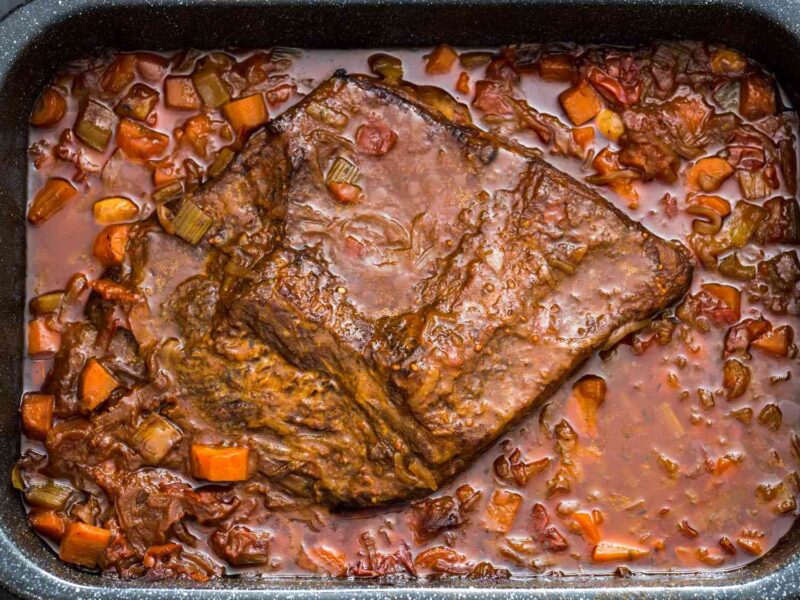
While smoking brisket is both a science and a craft, braising brisket is a tradition woven into the strands of culinary history. The method of braising is synonymous with comfort—brisket invited into a bath of savory braising liquids, a mingling of flavors, tenderly cocooned in a covered pot.
In my kitchen, to braise is to bring forth histories and heritages, as liquid and low heat bring out the fall-apart texture of brisket that has long graced family tables.
From the storied Jewish pot roast to countless generational recipes across cultures, the traditional brisket recipe is tenderly handed down, carrying the weight of legacies within each fiber tenderized by the craft of braising.
- Preparation: Season the brisket well and sear to lock in flavors.
- Liquid Gold: Select the braising liquid—wine, stock, or tomatoes, each imparting its unique profile.
- Tenderization: Endure the low-heat journey, watching connective tissues surrender to the warmth.
Whether a brisket aficionado or a curious newcomer to its charms, one quickly learns that low and slow smoking and traditional braising are not mere techniques—they’re testaments to time-honored practices that transform the toughest cuts into epicurean delights. 6 times the commitment, I assure you, 6 times the reward.
Breaking Down Brisket: The Flat and the Point Cuts
When I delve into the hearty world of briskets, it becomes clear that not all brisket types are created equal. A full brisket is a tale of two halves: the flat cut and the point cut. These two primary sections are fundamental to understanding how brisket can be prepared to perfection.
Let’s untangle the unique attributes of each, ensuring that your next brisket endeavor yields the succulent results that this cut stands famed for.
The flat cut is akin to the brisket’s dignified half—lean with a consistent thickness throughout and topped with a protective fat cap. As the deeper portion of meat attached to the rib cage, it is the epitome of the low and slow mantra, where the lean muscle’s richness is best unveiled through patient smoking that preserves its modest moisture.
Contrastingly, the point cut is the brisket’s more boisterous sibling. More robust in fat and connective tissue, this triangular section boasts a richer flavor, its marbling a promise of juiciness.
With a different grain direction compared to the flat cut, the point becomes the star of braising endeavors, its capricious fibers relenting into tenderness in the presence of a slow simmer.
The distinction between the flat and the point is paramount, as the carving course drastically impacts the end texture and flavor—slice against the grain, and the brisket rewards you; with the grain, and you face the ire of toughness.
| Cut | Characteristics | Cooking Recommendation |
|---|---|---|
| Flat Cut | Leaner, consistent thickness, with a fat cap | Low and slow smoking for moisture retention |
| Point Cut | Marbled with fat, thicker, richer in flavor | Braising to tenderize the dense fibers |
Understanding the intricacies of the flat and point cuts—each inherently magnificent—grants one the culinary wisdom to create a brisket experience tailored to the tastes and desires of their audience.
The flat cut, with its even, controlled cooking, or the point cut, is rich and willing to yield its flavors to the embrace of a gentle braise. My advice is to become acquainted with these brisket types, as each cut has a story—an ode to texture and savor waiting to be savored by any who appreciate the craft of cooking.
- Approach the flat cut as a canvas for the smoke, allowing the flavor to build with subtlety.
- Engage the point cut for a more unreserved burst of beefiness, its fat is a vehicle for carrying depth and a promise of succulence.
- When slicing, always remember to cut perpendicular to the grain, ensuring each portion falls apart with ease, a mosaic of tasteful brisket to be enjoyed.
In my culinary explorations, I’ve learned that the brisket speaks a language all its own—a language of texture, flavor, and intricate grain. It invites a conversation between chef and meat, a dialogue that begins with understanding the distinct nature of flat-cut and point-cut briskets.
As I continue to develop my craft, I heed the nuances of these cuts, each with its own dialect of deliciousness, and I optimize my approach to ensure that every brisket I prepare becomes a narrative of taste, ready to be relished in each tender bite.
Choosing Your Brisket: Tips for Selecting the Best Quality
Embarking on a quest to find the perfect brisket can be a rewarding culinary adventure. It begins with understanding the USDA grades and the importance of brisket marbling, factors that are essential for selecting a high-quality cut.
As a seasoned home chef, I can guide you through this process, ensuring that your brisket showcases the succulence and tenderness that only the best cuts can provide.
USDA Grades and Marbling
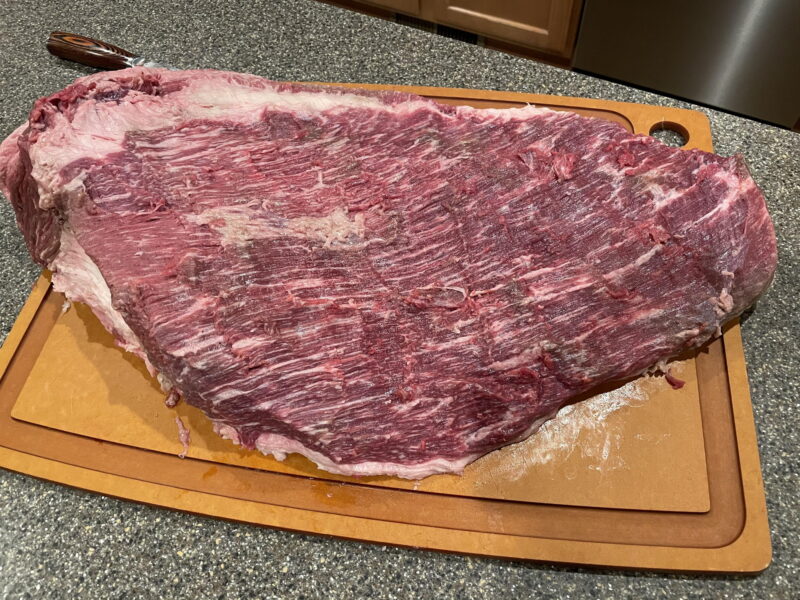
The USDA grading system is crucial when searching for the ideal brisket. As a mark of quality, these grades are indicative of the brisket’s fat content and marbling, the white flecks of fat within the muscle.
More marbling generally means a richer flavor and superior ability to retain moisture during a long, low-temperature cooking process. The USDA grades of beef are Prime, Choice, and Select—with Prime being the highest, followed by Choice, and then Select.
| USDA Grade | Marbling Level | Implication for Cooking |
|---|---|---|
| Prime | Abundant Marbling | Best suited for low-temperature smoking or braising methods |
| Choice | Moderate Marbling | Ideal for a balance of flavor and tenderness with proper cooking |
| Select | Least Marbling | More prone to dryness, requires careful cooking to enhance moisture |
Remember, the USDA grade serves as a signpost to quality, guiding you toward brisket selections with marbling that promises a moist and flavorful experience.
Wagyu Brisket: The Prime Choice
Wagyu brisket, with its legendary marbling, is the zenith of brisket choices. Since its introduction to the United States market in 1975, Wagyu beef has captivated chefs and food connoisseurs.
The intense marbling and rich taste of Wagyu brisket put it in a league of its own, placing it at the top of the hierarchy for those seeking a prime quality brisket for an unforgettable culinary endeavor.
- Wagyu brisket exhibits an extraordinary level of marbling, offering a unique richness that enhances its flavor profile significantly.
- The exceptional tenderness of Wagyu brisket makes it the preferred choice for enthusiasts aiming for excellence in their cooked brisket.
- Although it comes at a higher price point, the quality of Wagyu brisket often more than justifies the added cost for those in pursuit of a top-tier brisket experience.
And while the grade 8 brisket might be elusive, aiming for the highest quality within your means will pay dividends when it comes time to smoke or braise your chosen cut.
- Identify the USDA grade that suits your taste and cooking method preference.
- Examine the brisket marbling closely—the more, the better.
- Whenever possible, opt for Wagyu brisket to elevate your culinary creation to an outstanding status.
At Home With Brisket: Cooking Tips for Home Chefs
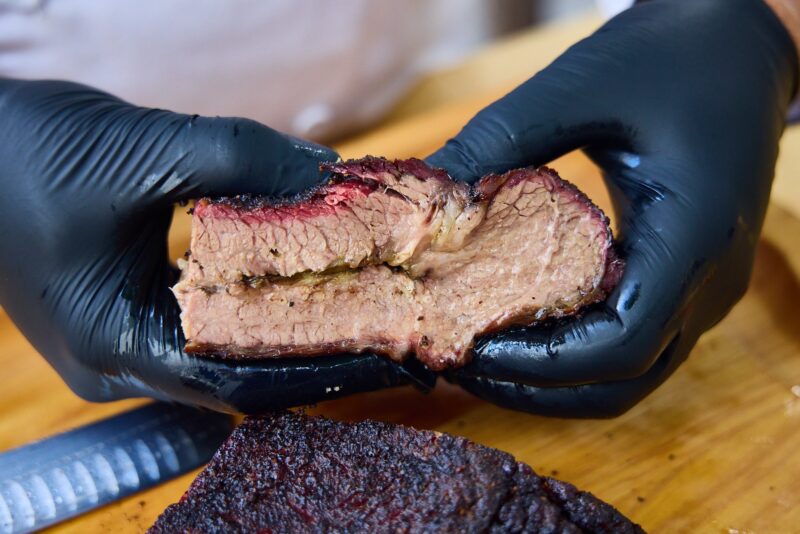
As a home chef who has delved deep into the art of brisket cooking, I’ve honed a collection of tips perfect for the home brisket preparation process. The journey to a succulent and flavorful brisket begins long before it reaches the heat—it starts right there on your kitchen counter with careful selection and preparation.
Let me share with you some nuggets of wisdom to ensure your brisket cooks to perfection.
Choosing the right size and shape for your brisket is crucial. You’ll want to ensure that the piece you select can properly fit within your oven or smoker. An evenly shaped cut will also aid in consistent cooking, avoiding overly dry or undercooked sections.
Brisket shrinkage is an inevitability due to the high moisture content of the meat reducing throughout the cooking process. Knowledge of this will help you consider an appropriately sized brisket that accounts for such reductions when serving your guests. Here are the steps I take for brisket success:
- I check my cooking equipment’s dimensions and compare them with the brisket size—insisting on an excellent fit.
- I select a brisket with an even shape, trimming if necessary, to ensure uniform cooking.
- I reserve ample time for the cooking process, knowing that a good brisket can’t be rushed.
- I anticipate shrinkage and buy slightly more than my final serving requirement.
Now, let’s talk about temperature and timing—your veritable allies in this quest. The key to that fall-apart tenderness is low heat and patience. This process is not to be hurried! A brisket cooked too fast will tighten up and become tough. Embrace the slow dance of cooking and you will be richly rewarded.
Remember, the warmth of your home will be filled not only with the sumptuous aroma of cooking brisket but also the sweet scent of anticipation. Treat each step with respect, and the brisket emerging from your kitchen will sing tales of your culinary expertise.
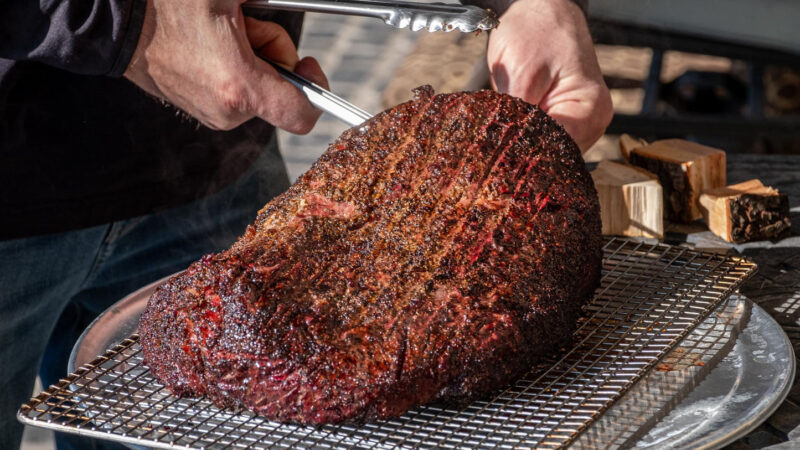
- Start with a low oven or smoker temperature, usually between 225°F to 250°F.
- Long cook times are expected, sometimes up to 1.5 to 2 hours per pound for the larger cuts.
- Arm yourself with a reliable meat thermometer to ensure you reach the right internal temperature without second-guessing.
For your culinary pleasure, I present a table of brisket cooking stages. This visual aid will guide you through the estimated cooking times and temperatures to achieve that perfect brisket every time you set forth on your home brisket preparation journey.
| Brisket Weight | Estimated Cooking Time at 225°F | Internal Temperature for Doneness | Post-Cook Resting Time |
|---|---|---|---|
| 3 lbs | 4.5 – 6 hours | 203°F | 30 minutes |
| 5 lbs | 7.5 – 10 hours | 203°F | 45 minutes |
| 10 lbs | 15 – 20 hours | 203°F | 1 hour |
To bring this guide to a close, I leave you with a final nugget of truth: the most profound flavors are often coaxed from simplicity. Allow yourself the simplicity of time and temperature control to unveil the complexities of brisket’s incredible flavors.
Commit to these pillars of brisket preparation and the satisfaction your completed dish brings will echo in the delighted expressions of those seated at your table.
Navigating Brisket Purchase: Where to Buy and What Prices to Expect
As a brisket enthusiast, the quest for the perfect cut takes me from the doorsteps of local butchers to the expansive aisles of big box stores. Each avenue offers a different experience, both in terms of quality and price point.
In this section, I’ll offer guidance on where you might choose to purchase your brisket and what financial considerations to bear in mind. Whether you’re a seasoned pitmaster or a novice ready to take on your first smoke, knowing where to source your meat and at what cost is foundational to your culinary success.
Local Butchers vs Big Box Stores
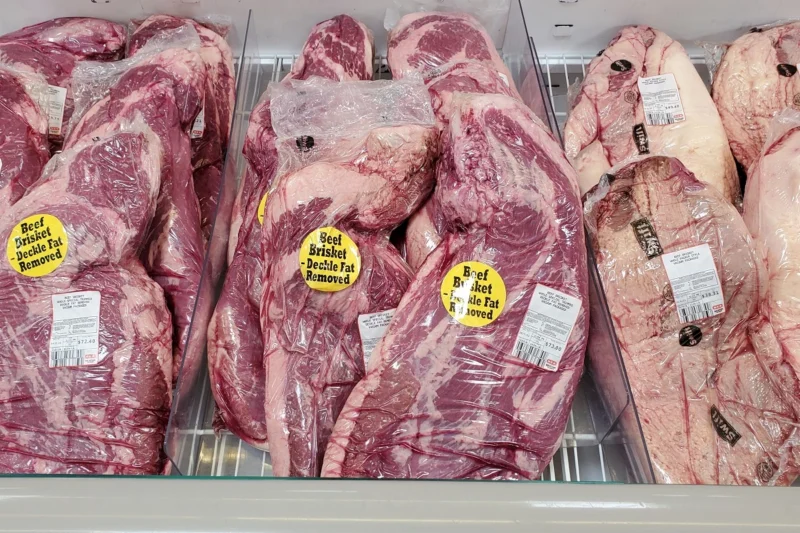
The decision between visiting a local butcher and stopping by a big box store is influenced by more than just the price. Local butchers pride themselves on the provenance of their meats and often provide a richer shopping experience with personalized service.
They may cut and trim the brisket to your specifications and offer invaluable tips that can turn a good cooking experience into a great one.
Conversely, big box stores might provide brisket at a lower cost, and their brisket, often referred to as Big box store brisket, can come in larger sizes, suitable for feeding a crowd or for those looking to get better bang for their buck.
Understanding Brisket Pricing
I’m often asked, “How much will a brisket set me back?” The answer varies and hinges on several factors, including the type of cut, current market price for beef, and, to a degree, the time of the year — think increased demand during the BBQ season.
Generally, a flat cut is more expensive than a packer brisket, often because it’s been further processed to remove excess fat and, in some cases, reduced to a more manageable size.
| Store Type | Advantages | Average Cost per Pound |
|---|---|---|
| Local Butchers | Higher quality, customized trimming | $6 to $8 |
| Big Box Stores | Economically priced, larger cuts | $2 to $3 |
When selecting your brisket, ensure you take into account the meal you’re preparing.
Paying a premium at a local butcher might yield a quality that elevates a simple meal to a memorable feast, whereas a big box store brisket may serve you better when cooking in bulk, without sacrificing too much on flavor, especially if you’ve mastered your brisket rub and smoking technique.
In summary, understanding the nuances of brisket pricing, from the local butcher’s premium selections to the big box stores’ economical prices, is a skill that I’ve sharpened over countless barbecue seasons.
It’s not just about the price per pound but the quality, the service, and ultimately, the flavor that lands on your plate. When I step out with my list in hand, ready to procure that all-important brisket, I keep these factors, especially the number 10 — pounds, that is — at the forefront of my decision-making process.
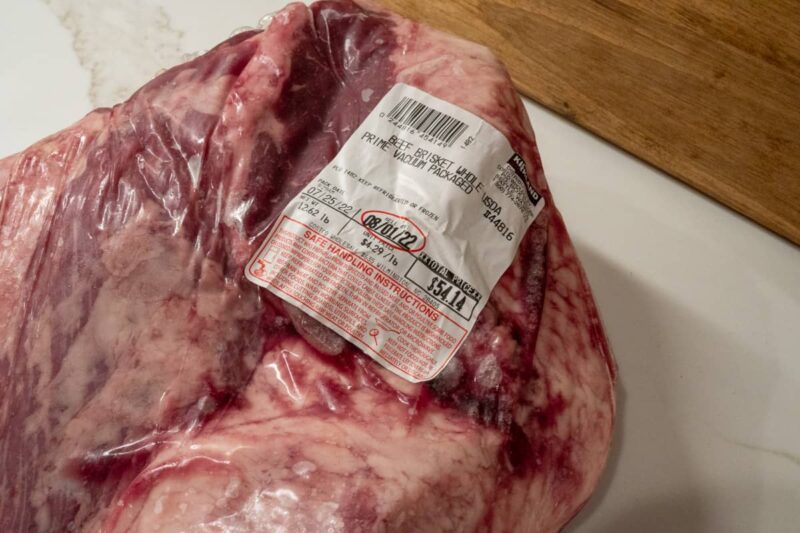
Crafting the Culinary Delight: Brisket Recipes Worth Trying
In my culinary explorations, I’ve developed a passion for transforming the traditional into the extraordinary. The classic smoked brisket stands as a pillar of American barbecue, a testament to the beauty that can be achieved through patience and a commitment to process.
Below, I share one of my favorite recipes for a classic smoked brisket and provide a delicious way to repurpose leftovers into creative dishes that will keep the brisket love going.
Classic Smoked Brisket
The heart of a good smoked brisket lies in the rub recipe—a simple, but powerful blend of salt, pepper, and mustard rub forms the backbone of Texan tradition.
The magic unfolds slowly, with carefully monitored temperatures and a lovingly tended smoker working in tandem to coax out the flavors and achieve a tender, moist, and richly flavored brisket complete with that coveted pink smoke ring.
| Ingredient | Quantity | Purpose |
|---|---|---|
| Kosher Salt | 1/4 cup | Main seasoning for crust formation |
| Coarse Black Pepper | 1/4 cup | Bold flavor and texture contrast |
| Garlic Powder | 2 tablespoons | Aromatic depth |
| Smoker Wood Chips | As needed | Infuses brisket with smoky flavor |
My brisket begins with a brisket rub recipe that honors these core ingredients. It’s the simplicity of this rub that allows the classic smoked brisket to truly shine. I ensure the entire brisket is covered and then I leave it to marinate, allowing the flavors to deeply penetrate the meat before it even hits the heat.
When the brisket is ready for the smoker, I maintain a consistent temperature of 225°F. The time it takes can be painstaking—up to 16 hours for a full packer brisket—but the results speak for themselves: a crusty bark outside and tender perfection inside.
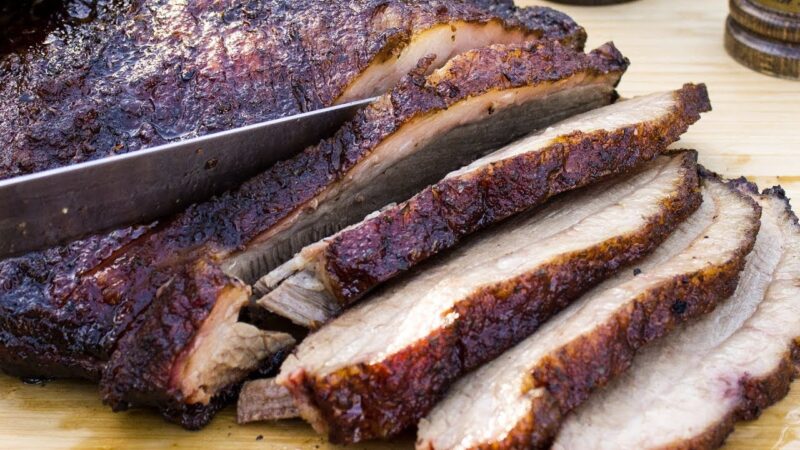
Repurposing Leftovers: Creative Brisket Dishes
It’s not often that I have leftovers from a brisket meal, but when I do, I embrace the opportunity to get creative. There’s a certain joy in giving new life to brisket, and I’ve found the following dishes to be particular crowd-pleasers:
- Brisket Grilled Cheese: Melted cheese hugs tender chunks of brisket between slices of buttery, toasted bread. It’s comfort food elevated.
- Brisket Nachos: Crisp tortilla chips loaded with brisket pieces, draped in melted cheese and garnished with your choice of toppings for a fusion of flavors and textures.
- Brisket Tacos: Soft tortillas filled with brisket, fresh cilantro, onions, and a drizzle of lime create a perfect quick meal that’s brimming with taste.
Each dish provides an opportunity to explore different spices and cuisines. Even the braising liquid from the original cook can be repurposed to add another layer of flavor. Whether using it as a dipping sauce or a base for a rich gravy, the possibilities are endless and delightful.
Part of the appeal of brisket is in its second act, the creative ways meat lovers have come up with to enjoy brisket beyond its initial presentation. Waste not the brisket; its culinary potential stretches well past the first cut.
To me, brisket is a canvas of possibility. Beginning with the classic smoked brisket, ripe with tradition, and extending into the realm of inventive leftover transformations—every bite tells a story.
A story of heritage, innovation, and a shared love for a cut that weaves its way into the fabric of American cuisine. So the next time you find yourself with a glorious piece of brisket, remember, the story doesn’t end with the last slice served; it’s just getting started.
Brisket’s Influence: Cultural Significance and Celebratory Dishes
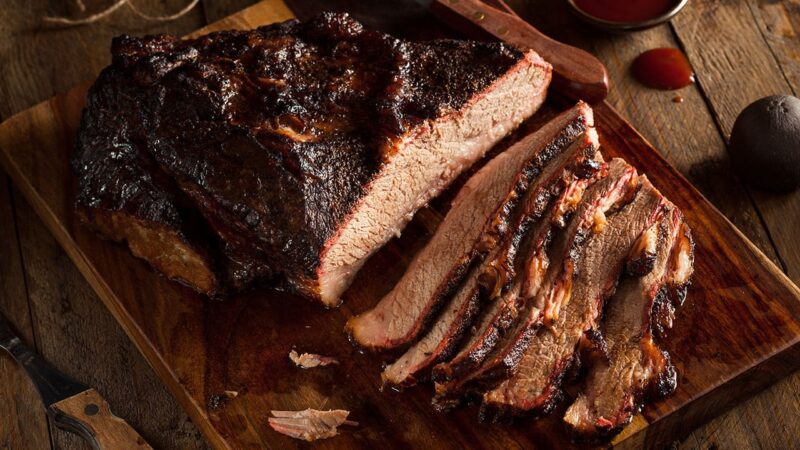
Brisket’s journey through cultural gastronomy illustrates how certain foods become interwoven with tradition and celebration. Its cultural significance of brisket resonates across various festivities worldwide, where it is more than just a meal; it’s a medium of expression and a fixture at gatherings.
Reflecting on the numerous brisket celebratory dishes I have had the pleasure of experiencing, I observe that brisket holds a unique place in the hearts of communities due to its versatility and hearty nature.
The presence of brisket on a festive table speaks volumes of its culinary prominence—it is often the star of the meal, telling stories of heritage and uniting guests in shared indulgence.
The history of brisket, notably in the Jewish tradition, sees this cut of beef taking center stage during Rosh Hashanah and Passover feasts. It’s a symbol of jubilation, with each slice representing a narrative embedded in cultural lore.
In Texas, meanwhile, the phrases “brisket” and “celebration” are virtually synonymous, as the cut is a cornerstone of barbecue cook-offs and family reunions.
| Culture | Brisket Dish | Occasion |
|---|---|---|
| Jewish | Braised Brisket | Rosh Hashanah, Passover |
| Texan | Smoked Brisket | Barbecue Competitions, Family Gatherings |
| Asian | Brisket Soup | New Year Celebrations, Festivals |
Each culture imparts its own flavor profiles to brisket, creating a global spectrum of tastes, where spices and cooking methods reflect local preferences. The traditional Korean Seollal, for example, often includes a savory brisket dish that is shared among family members, symbolizing communal bonds and prosperity for the new year.
In my own culinary endeavors, I have found that brisket’s adaptability is unmatched, absorbing a variety of seasoning blends that suit the character of each occasion.
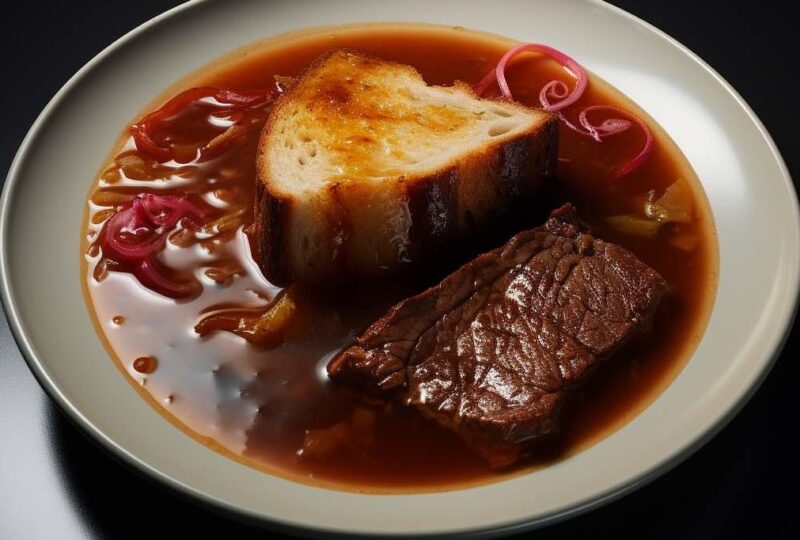
This understanding compels me to consistently incorporate brisket into celebratory dishes, embracing the joy it brings to guests and the satisfaction it lends to festive meals.
- Brisket adapts to the cultural palate, whether braised with pomegranate and red wine for a Passover Seder or boldly smoked with a simple rub that lets the meat’s natural flavors shine through.
- In celebrating moments of togetherness, brisket’s heartiness guarantees a sense of fulfillment, providing a centerpiece that celebrates both the simplicity and profundity of a shared meal.
- My ultimate goal as a chef is to honor the traditions brisket carries with it, allowing those at my table to connect to the rich cultural tapestry it represents.
- Experiment with spices and cooking techniques to accentuate brisket’s versatile nature.
- Embrace brisket in celebratory dishes as a means of paying homage to cultural practices and creating new traditions
- Recognize the binding factor of brisket in its ability to unite people through shared dining experiences.
Reflecting on the cultural significance of brisket is to acknowledge its power to transcend boundaries and foster connections. It is a testament to how certain dishes, like brisket, gain an esteemed place in social and cultural circles and in the true spirit of hospitality, bring people together in celebration.
FAQ
What is brisket and why has it become so popular?
Brisket is a cut of beef from the lower chest of a cow, known for its connective tissue which makes it tough yet flavorful when cooked correctly. Its popularity has soared due to its rich taste and cultural significance in cuisines like Texan barbecue and Jewish holidays, turning it from a low-value cut to a culinary delicacy.
Can you provide a basic brisket recipe for first-timers?
Certainly! A basic brisket recipe involves seasoning the meat with a simple rub, like a mixture of salt and pepper, then smoking or braising it at low temperatures for several hours until it achieves a tender texture. It’s best to follow a detailed recipe guide specific to your cooking method of choice.
What transformations has brisket undergone in its culinary history?
Brisket’s culinary history features a transformation from a cut primarily used for ground beef to a gourmet meat due to improved cooking techniques and its importance in various cultural dishes. It has transitioned into a premium cut appreciated in high-end dining and casual culinary settings alike.
What are the key points to know about brisket tenderness?
Brisket tenderness largely depends on the cooking technique. Smoking or braising the meat ‘low and slow’ allows the tough connective tissues to break down over time, rendering the fat and ensuring a tender, juicy result. Cooking time and temperature are critical for achieving the desired tenderness.
What are the differences between the flat cut and the point cut of brisket?
The flat cut of the brisket is leaner and has a consistent thickness, which makes it good for slicing. The point cut is fattier, thicker, and more marbled, giving it a richer flavor. Both require different techniques and cooking times due to their distinct textures.
How do USDA grades and marbling affect brisket quality?
USDA grades, such as Prime, Choice, and Select, indicate the level of marbling and overall quality of the beef. Marbling refers to the intramuscular fat that enhances flavor and moisture. Higher marbling, often found in Prime grades, is preferred for brisket as it can endure long cooking processes and still remain tender and flavorful.
What makes Wagyu brisket a prime choice and how does it differ from other briskets?
Wagyu brisket is renowned for its exceptional marbling and tenderness, which come from a specific breed of Japanese cattle. The high intramuscular fat content provides a rich, buttery flavor and a melt-in-the-mouth texture that sets it apart from other types of brisket. Although it’s a premium option, many barbecue enthusiasts consider it worth the investment.
What should home chefs know about cooking brisket?
Home chefs should know that cooking brisket requires patience and attention to detail. It is crucial to choose the right size for their cooking equipment, allow for proper preparation time, and be aware of the shrinkage that occurs during cooking. Additionally, using a meat thermometer to monitor internal temperature ensures perfect doneness.
Should I buy brisket from a local butcher or a big box store?
Purchasing brisket from a local butcher can offer higher quality meat and personalized service, while big box stores may provide more economical prices for larger quantities. Both have their advantages, and the choice depends on your priorities, such as quality, price, and the level of expertise the seller can provide regarding brisket preparation.
How much can I expect to pay for brisket and does it vary?
The cost of brisket varies widely based on factors like meat grade, geographic location, and time of year. Prices for flat cuts can range from $6 to $8 per pound, whereas packer briskets are generally cheaper, at about $2 to $3 per pound. Market conditions and availability also significantly impact brisket pricing.
Do you have suggestions for repurposing brisket leftovers into new dishes?
Brisket leftovers can be repurposed into a variety of dishes, such as brisket tacos, brisket chili, sandwiches, and more. The rich, smoky flavor is versatile and can enhance many different recipes, making leftovers just as exciting as the original meal.
What is the cultural significance of brisket, and why is it featured in celebratory dishes?
Brisket’s cultural significance arises from its central role in traditional dishes across various cultures, such as Jewish, Texan, and Korean cuisines. It is often a centerpiece during celebrations and holidays due to its size and the communal cooking process involved, creating a sense of tradition and nostalgia.
Conclusion: Brisket’s Culinary Legacy
My immersion in the brisket culinary journey has revealed the depth and versatility of what was once an overlooked cut of beef. Through the lens of tradition and with the touch of innovation, brisket’s enduring appeal is etched in the heart of culinary cultures far and wide.
It is the very essence of transformation—where the once gritty and hardworking cut has become synonymous with gourmet experiences and familial comfort. The flavors that brisket endures to take on and the stories it tells through its smoky rings and tender fibers speak to its timeless allure.
As brisket maintains its stature across a broad tapestry of practices, from the Texas pits to the sacred tables of Jewish feasts, it has become a culinary staple for those who prize both its classic and reinvented forms.
Whether I’m enveloped in the aroma of a brisket smoking gently for hours or slicing through a beautifully braised piece, it is evident that brisket is not just food—it’s an experience, a craft that demands respect, patience, and an understanding of its distinctive narrative.
In reflection, brisket’s evolution is a testament to how adaptable and dynamic the world of food truly is. The lessons in patience, technique, and cultural reverence I’ve gleaned from the brisket’s story are emblematic of the broader journey we share in the kitchen and at the table.
So here’s to the brisket—may its culinary journey continue to inspire and bring warmth to the tables and hearts of chefs and food lovers alike.

